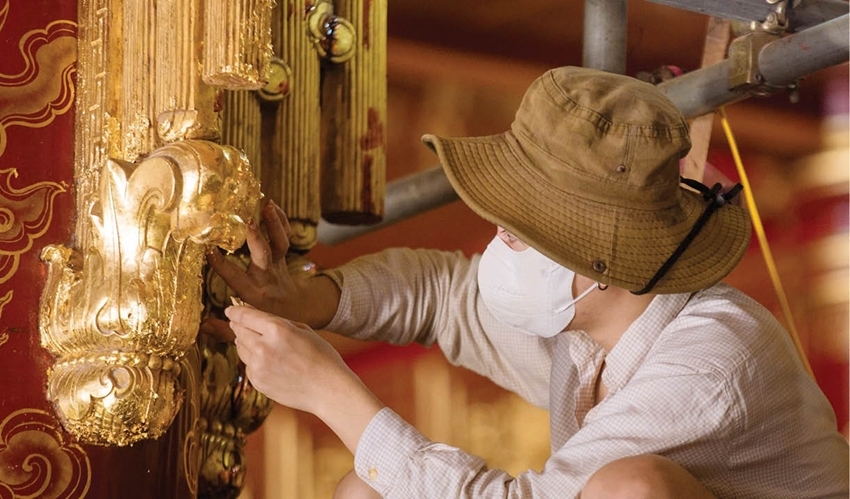 |
| Each craftsperson needs not only technique, but also heart and vision |
Cultivating creativity through artisanal passion
Behind the stage lights of Hue Royal Traditional Arts Theater are the dedicated practice sessions of young performers and artists. They rehearse character roles in classical opera excerpts and court music compositions. Meritorious Artist Hoang Trong Cuong - Director of the Theater shares: “Training newcomers is difficult, keeping them is even harder.”
Performing traditional arts, especially forms like tuong opera, Royal Court Music, or Dance, requires not only talent but also persistence and rigorous training. “Some students begin learning tuong from an early age, but it takes a decade to play a leading role. Without passion, they would have given up long ago,” says Mr. Cuong.
Challenges come not only from the specialized nature of Court arts but also from the economic reality that contemporary artists struggle to earn sustainable incomes that would enable their full dedication to these traditional practices. That’s why the Theater has chosen the “direct mentoring” training approach, while Hue Monuments Conservation Center supports mechanisms for artists to earn additional income from performances, projects, and creative spaces.
Recently, with sponsorship from the Vingroup Innovation Foundation (VinIF), the Theater implemented a three-month training course on tuong mask painting techniques. As a result, 15 young artists completed 300 tuong masks - bringing to life the vivid faces of Tru Vuong, Dao Tam Xuan, Ly Ngu Tinh... Each mask carries the colors and artistic lines of tuong opera along with a love for heritage.
The course was directly taught by Meritorious Artist La Hung. “He not only teaches the craft but also the history behind each facial feature,” says Le Mai Phuong, Head of the Theater’s Research and Application Section. Though only three months long, the project has long-term significance, helping young artists themselves design masks to proper court artistic standards. From these results, the Theater plans to open annual classes so that every new artist can thoroughly learn traditional identity.
“We don’t force but let them find their own way. Only when they truly love it will they have enough patience to pursue a specialized art form like court tuong,” says Ms. Phuong.
Retaining skilled craftspeople
Not just artists, but artisans, skilled craftspeople, and restoration workers who reconstruct and preserve monuments are also facing workforce shortages. According to Mr. Hoang Viet Trung - Director of Hue Monuments Conservation Center, this workforce is aging, while younger generations show less interest because the work is arduous with modest income. “When one craftsperson quits, it’s a significant loss. Training takes decades," says Mr. Trung.
In our conversation, artisan Ngo Dinh Trong – Head of the Painting Team at Hue Monument Restoration Joint Stock Company explains: Gold-leaf application techniques cannot be learned in a day or two but require lifelong refinement. The lacquered and gilded components are the soul of court architecture. Most skilled craftspeople in his team were taught by the late artist Do Ky Hoang, a lecturer at Hue University of Arts. Practitioners must have a deep understanding and love for the craft to infuse spirit into each layer of gold leaf and paint stroke.
Currently, many specialized traditional crafts are only passed down orally through family lines without formal certification. “We need policies to recognize, support, and honor them as ‘living heritage.’ They are not just craftspeople but keepers of the heritage’s essence,” emphasizes Mr. Trung.
“We hope to establish a specialized training center for traditional crafts focused on heritage reconstruction. There, students and craftspeople would learn through hands-on experience, directly touching heritage. The Center highly values the role and contributions of artisans. We have awarded certificates of merit to hundreds of artisans and skilled workers restoring Thai Hoa Palace. This is not just gratitude but motivation to keep them in the profession,” adds the Director of the Hue Monuments Conservation Center.
In the heart of the ancient capital, tuong opera classes still resound with drum beats, restoration sites buzz with chisel sounds, and young craftspeople’s hands still learn ancestral techniques. Keeping them engaged in restoration work is preserving heritage itself.